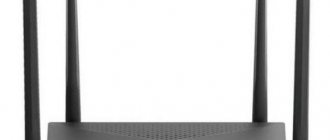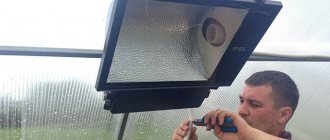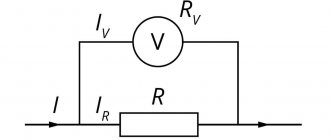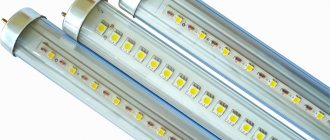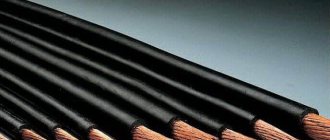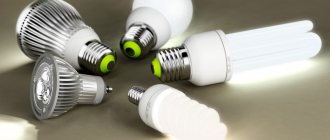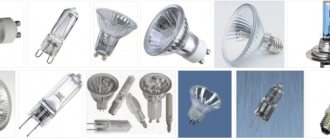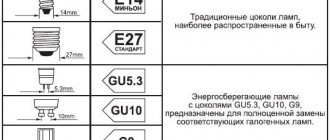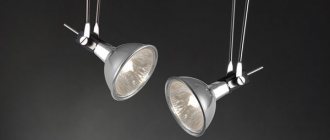Greenhouse lighting lamps are vital for plants. Without enough light, the stems stretch, the fruits do not ripen properly and lose their taste. That's why it's so important to choose the right lamp!
Artificial lighting in a greenhouse allows you to accelerate or slow down the development of plants, as well as the ripening of crops, regardless of the time of year, and reduces the level of nitrates in leaves and fruits. Since green crops require at least 12 hours of light per day, it is worth taking care to install high-quality lamps in the room.
24-hour lighting for plants is contraindicated. They also require at least 6 hours of darkness for normal development.
Regular incandescent bulbs are not suitable for greenhouse lighting because they emit too much heat and do not contain the full spectrum needed. Also, in terms of the emitted spectrum, energy-saving fluorescent lamps are not very suitable, although some use them when growing plants. Therefore, more and more often, summer residents are paying attention to specially designed phytolamps of various types.
Light and its importance for plants
With a lack of daylight in winter and autumn, crops begin to wither and become sick. The key to the survival and healthy existence of plants is photosynthesis. Full photosynthesis is impossible without light. When plants produce chlorophyll, they fully absorb the carbon dioxide needed for nutrition. The formation of organic substances in greenhouse crops is impossible without solar and artificial lighting.
Signs of lack of lighting:
- changes in plant shape (for example, unnatural elongation of cuttings and stems);
- their slow growth;
- lack of flowering;
- drop in yield;
- the lower foliage turns yellow.
You may be interested in:
DIY lighting for seedlings Not a single living organism is capable of existing without light. Plants, especially in the initial stages, need...Read more...
How to make lighting with LED lamps
Do-it-yourself greenhouse lighting requires knowledge in the field of electrification. To begin with, a pre-prepared cable is pulled from the protective shield to the greenhouse. The cable is buried underground and a trench is dug especially for it.
The poles on which the lamps are placed are installed. Electrification work in the future requires the correct distribution of cables throughout the greenhouse and installation of lamps, taking into account all safety requirements.
- Calculations are carried out for the correct location. All indicators depend on the size of the greenhouse and the number of crops, their type and location in the room.
- It is also possible to carry cables through the air, but this requires a certain number of posts and special fasteners to secure the wires.
- As a rule, the distance between the posts should be about 2 meters.
When placing the cable underground, the trench depth should be 80-90 cm.
Light spectrum and its influence
Plants respond best to red and blue rays of the light spectrum. When lighting a greenhouse in winter, you need to ensure that the crops are not deprived of natural light. Also, you should not use rays of only one spectrum, if we are not talking about colors. This is useful for flowers: their color becomes rich and bright.
Rays of light affect greenhouse crops in different ways. Blue light stimulates photosynthesis, orange and red improve flowering. There should not be many of these flowers, otherwise the plants die. Ultraviolet radiation promotes the formation of vitamins. Thanks to it, the seedlings become resistant to winter cold.
Important!
Green and yellow lights cannot be used. Plants become deformed and their stems become thin.
When selecting lamps for a greenhouse, their colors should be different. When installing equipment, it is important to comply with lighting standards in accordance with the requirements in the region and the characteristics of the crops.
Norms and requirements
Plants react differently to light radiation. Therefore, before purchasing and installing phytolamps in a greenhouse, you need to know what spectra crops need for growth and development.
Yellow and orange light 600-620 nm is not suitable for flowering and fruit-bearing plants. However, it stimulates the elongation of stems in ornamental crops. Red spectrum 630-660 nm – necessary for any plants at all stages of growth for accelerated development, flowering and fruiting. Blue light 400-520 nm also stimulates the growth and development of crops, activating photosynthesis processes. Strengthens the root system, increases green mass. Green spectrum 500-600 nm - in combination with blue light, promotes the formation of chlorophyll in chloroplasts and the accumulation of vitamins. However, if you install only green spectrum phytolamps, this can harm the plants. Ultraviolet 280-400 nm – increases green mass and strengthens the root system of crops. In addition, under the influence of ultraviolet radiation, harmful bacteria die and plants grown in greenhouses develop better and faster. Infrared light from 780 nm is close to sunlight, thanks to which plants quickly grow, bloom and bear fruit. However, long-term exposure to such radiation is detrimental to most crops. Violet spectrum 400-430 nm - through this lighting, plant trunks are strengthened and their resistance to external factors increases.
To select a phytolamp, you should pay attention to the spectrum it emits. Many modern models combine a combination of several types of lighting. Then it all depends on the type of plant being grown and the result you want to achieve. You can install different phytolamps in a greenhouse and see how they affect crops.
Night illumination
The use of lighting devices around the clock will not benefit plant crops. They need about 6 hours of complete darkness to rest. There are vegetables, berries and plants that need individual lighting conditions.
Cucumbers cannot tolerate a pause between different types of light. When growing cucumbers, natural and artificial lighting should alternate evenly. After the first cucumber seedlings sprout, they need to be illuminated regularly. Onions and herbs need additional lighting only at the initial stage of growth. Strawberries require additional lighting during the day and at night.
Greenhouse lamps - pros and cons of different types
radmegan.com
A lamp that would ideally reproduce sunlight has not yet been invented. Therefore, greenhouse owners are most often guided by the characteristics of the selected lamp. So, a good phytolamp for plants should:
- emit a balanced amount of red and blue rays (to the human eye such light appears violet-pink);
- be durable and economical;
- consume a small amount of electricity;
- be easy to use and environmentally friendly;
- Do not get too hot during operation.
Now let's look at several popular types of greenhouse lights that will help you grow tasty crops.
LED lamps for greenhouses
LED lighting for greenhouses is considered the most economical and safe. The fact is that there is high humidity in greenhouses, and a low-voltage power supply is sufficient to operate these lamps. The service life of the equipment can reach 50 thousand hours. But such lamps also have a significant drawback - the high price, which significantly increases the cost of the grown crop.
Currently, greenhouses use LED lamps equipped with LED lamps. Depending on their number, it depends on how much light the plants will receive and what the power consumption will be.
ICE (LED) lamps for greenhouses can also be installed in winter gardens and greenhouses. Photo source: promled. com
In greenhouses, you can also use an industrial LED lamp, which consumes little electricity and instantly lights up to the desired brightness.
Sodium lamps for greenhouses
agriexpo.online
Sodium lamps for greenhouses emit a red spectrum of light, which is indispensable for plants during the period of flowering, ovary formation and fruiting. Such equipment is durable and economical. But sodium lamps also have disadvantages. If used during the growing season, the plants may become too elongated due to the predominance of red-orange light in the lighting. In addition, they heat up quickly (which can be a plus in winter) and contain toxic metals, so they require careful handling. Breaking such a lamp is dangerous to health.
A sodium lamp is sometimes abbreviated as sodium arc tube lamp.
DNaT lamps are used not only for greenhouses, but also for greenhouses, flower beds, nurseries, greenhouses, growboxes (boxes for growing plants), etc.
Infrared lamps for greenhouses
stroy-podskazka.ru
Infrared lamps are used to heat greenhouses and create comfortable living conditions for plants. Thanks to these devices, you will no longer need stove or electric heating. Moreover, such lamps do not heat the air, but transfer heat directly to the ground, which itself releases the received energy into the surrounding space. As a result, the air does not dry out, and the plants feel almost like they are under the real sun. The device operates silently, is easy to adjust and saves energy. The spectrum of such a lamp is not suitable for high-quality lighting, so you will have to purchase other lamps.
Lighting time
The lighting time depends on how light-loving the crop is. For tomatoes, cucumbers, salads and bell peppers, the length of daylight should be 10 hours or more.
There are short day plants. It is the short daylight hours that cause them to begin to bloom. When daylight hours become longer, their growing season comes to an end and they begin to develop as usual. In long-day plants, flowering occurs when the daylight hours are more than 13 hours. If it is shorter, their fruits will become small or stop appearing altogether.
There are cultures for which the length of daylight hours does not matter. They grow independently of it, the main thing is that there is not too little light. If there is not enough of it, the plants will die.
Proper illumination of seedlings in a greenhouse with a phytolamp
Phytolights are installed above the plants. Installing phytolamps in greenhouses on the side leads to bending of the stems and their fragility, including under the weight of the fruit. If the height, power and spectrum of the phytolamp are selected correctly, then the crops will have a healthy, well-groomed appearance.
To properly illuminate the seedlings, powerful phytolamps with a different spectrum of exposure are installed in the greenhouse, based on the characteristics of the plants being grown, the season, the type and shape of the lamps and the required illumination area.
Types of greenhouse lamps
You can illuminate a greenhouse with several types of lamps:
- incandescent;
- luminescent;
- sodium;
- mercury;
- metal halide;
- LED;
- infrared.
Incandescent lamps
They illuminate the greenhouse room well and also warm the air a little. Their disadvantage is that they consume a lot of electricity and have low efficiency. Their incandescent spectrum is 600 nanometers. If plants are overheated, they will get leaf burns. Burns occur due to excess infrared, orange and red light. Also, when overheated, the stems become unnaturally stretched, and the foliage becomes deformed, becoming small and limp.
Fluorescent lamps
The color spectrum of fluorescent light bulbs works well for greenhouse crops. They last a long time and their cost is low. These lamps work in the same way as energy-saving lighting fixtures, but can illuminate a larger area. These are fluorescent lamps: they illuminate both seedlings and grown plants. For their installation, metal boxes are used, as well as special lighting fixtures made of plastic.
Sodium lamps
These are economical light bulbs that operate under high pressure. Previously, their color spectrum was only red-orange, close to the rays of the sun. There were few blue rays from sodium lamps. In this regard, a modification was made, as a result of which lamps with a blue spectrum of light rays appeared.
On a note!
Despite improvements, sodium-based lamps attract harmful insects. This makes them difficult to use in greenhouses and greenhouses.
Mercury vapor lamps
Mercury lamps provide near-ultraviolet light that is beneficial for crops. These are compact and bright light sources. Ultraviolet light helps to activate photosynthesis processes, but it should not be abused. The use of mercury lamps is possible provided they are combined with natural lighting. They are used when the fruits begin to ripen. To work with mercury, a stable voltage in the electrical network is required. In this case, differences of no more than 5% are allowed.
Metal halide lamps
The light spectrum of metal halide lamps is well suited for plants. These light sources are compact but difficult to install. After their service life has expired, they must be recycled and not thrown into the general garbage chute. Despite this specificity, metal halide lamps have a high level of light transmission. They are ideal as daytime lighting sources if the mains voltage is not subject to strong surges. With the slightest change in voltage, the color spectrum of these lamps will change. If the light source is turned off, a short time must pass before operation is restored.
Not every gardener can afford to use metal halide lamps due to their high price and sensitivity to mains voltage.
LEDs and their applications
LED lamps are so diverse that you can choose any color spectrum by making a combination of several lamps. Gardeners select different colors for each plant crop. LEDs last a long time and consume minimal electricity. They are placed at different heights, adjusting the light intensity. Light bulbs that produce blue colors are suitable for seedlings. For fruit ripening, rays of the red and orange spectrum are used. It is necessary to take into account the sensitivity of LEDs to voltage changes and monitor the condition of the electrical wiring. If the electrical wiring is in good condition, they will justify their cost in the first season of use.
Ultraviolet lamps
They work in the same way as fluorescent lighting sources. Ultraviolet radiation appears in the flask container. It appears due to the reaction between mercury and an electromagnetic discharge. The gas discharge tube is made of uvila or quartz glass, which transmits UV radiation. Uviol glass is considered safe because it produces less ozone. The composition of glass used to make UV lamps varies. This allows you to create light sources that operate in a specific color range.
Infrared heaters
They are used to heat plants. Infrared light sources are classified as energy-saving systems. They create a favorable microclimate in the greenhouse. Thanks to him, cultures develop no worse than in the natural environment. The luminaires are equipped with a manual or automatic control function that allows you to control and change the indoor air temperature. Convector heaters can only heat air.
Information!
Infrared lamps first give off heat to plants and the ground and only then heat the air.
Types of phytolamps for greenhouses
Various phytolights are used to grow crops in greenhouse conditions. The choice should be made towards those phytolamps that are optimally suited to the size of the greenhouse, the type of plants grown and the type of greenhouse. There are the following types of phytolamps for greenhouses: Fluorescent - these lamps, due to the combination of cold and warm light, are suitable for growing seedlings and greenhouse plants. They have low heat transfer, so even low mounting of lamps does not harm the crops. Another advantage is their low cost. However, they take up a lot of space, do not tolerate high humidity well, and a large greenhouse of fluorescent lamps will require a significant number of them.
Incandescent lamps are used quite rarely and only in small greenhouses, as they consume a large amount of electricity and, if installed incorrectly, can lead to burns on the leaves of grown plants. In addition, if the greenhouse does not provide for the removal of excess heat, crops may overheat due to high heat transfer from incandescent lamps. Such lamps are not used as the only sources.
Sodium phytolamps - in greenhouses, lamps of at least 400 W are used. Widespread due to lighting close to sunlight.
However, due to their high heat output, ability to attract insects and disposal problems, such lamps are used only by experienced farmers in high-tech greenhouses for large-scale crop production. Typically, sodium phytolamps are installed in greenhouses in winter. Mercury phytolamps - activate photosynthesis processes in plants. The lighting combination contains ultraviolet. Therefore, such lamps are perfect for lighting plants at the flowering and fruiting stages. The disadvantage is disposal. Due to mercury vapor in lamps, they must be disposed of promptly even if the slightest damage is detected.
Ultraviolet phytolamps - the body of such lamps is made of quartz or uviol glass. In the latter case, lamps are more in demand due to reduced ozone formation. Ultraviolet light promotes the accumulation of vitamins in plants, which strengthens them and creates optimal conditions for rapid growth and development. In addition, in such phytolamps you can adjust the required spectrum and select the optimal type of lamps.
Infrared phytolamps are the most popular and optimal option for lighting greenhouses, especially in winter. The emitted light is close to natural, making it possible to grow any crops all year round. The lamps are economical, do not dry out the air, warm the soil and are safe for plants and people. Many manufacturers of infrared phytolamps equip them with thermostats to regulate the emitted light.
LED phytolamps - allow you to customize spectra for specific types of crops. Thanks to their directional action, agricultural lamps evenly distribute lighting throughout the entire volume, minimizing light scattering. LEDs are practical, economical and are the best option for illuminating plants grown in greenhouses and at home.
Metal halide phytolamps compete with LEDs due to their characteristics. Such lamps are energy efficient, although economical, have a high level of color rendering, wattage range, long service life and resistance to high temperatures.
The disadvantages include non-repairability, danger of lamp explosion due to power surges, problems with disposal and high cost.
The diagram shows the results of studying different lamps during operation:
How do different greenhouses light up?
Polycarbonate greenhouses are often found in summer cottages and private areas. Greenhouse structures for industrial purposes are made of glass. Different types of greenhouses use different light sources, depending on the crops growing in them.
You may be interested in:
Radishes in a greenhouse in winter: cultivation and care, cultivation as a business Seasonal cultivation of radishes in a greenhouse in winter is a task that beginners can do. The first rule is choice...Read more...
Lighting for polycarbonate structures
Small greenhouses are built from polycarbonate for growing homemade vegetables, fruits, and berries. The good light transmittance of polycarbonate sheets makes it possible not to use additional light sources in the summer. In autumn, winter and early spring you need to learn the right combination of natural and artificial lighting. If you calculate everything correctly, you can make a profit from every square meter of a greenhouse or greenhouse.
The following are used as artificial light sources:
- fluorescent lamps;
- LEDs;
- ultraviolet.
Industrial greenhouse complexes
Incandescent lamps are not used in industrial greenhouses. For lighting industrial greenhouse complexes the following is used:
- sodium lamps;
- metal halide lamps.
As already noted, the light spectrum of sodium lamps is similar to sunlight. Despite the risk of attracting harmful insects, sodium light sources are economical and can be used for a long time. Growers value sodium lamps for their red and blue spectra, which are necessary for all types of crops.
The wide spectrum of radiation of metal halide lamps also allows them to be used on an industrial scale. The high price does not stop professional growers, because metal halide lamps are compact and have a wide light spectrum.
Popular lamps for greenhouses
The Levella phytolamp is a unique development for city farmers. To make it easier to find the required lamp, the product line from Big Cock Design is represented by a wide selection of phytopanels for a specific plant.
The design of the phytolamp can be completed according to any request. In addition, the company produces phytolamps of any size, spectrum and with those parameters that will solve the tasks at a high level. Phytolamp SKELETON 2.0 and 3.0 are configurations of one model with more improved technical characteristics. The best option for those who have seriously started or are already engaged in growing plants, both for their own use and on an industrial scale.
The Flasher phytolamp for plants has a large selection of spectra for any plants at different stages of growth. Uninterrupted operation of the module is designed for 50,000 hours. The phytolamp has proven itself well on the Russian market of phyto-devices. You can assemble the necessary equipment according to any request.
You can buy an industrial panel for growing plants with free delivery by leaving a request or contacting our managers by phone listed on the website.
BACK TO SECTION
How different plants are lit
Some gardeners consider cucumbers to be an unpretentious crop, but this is not entirely true. If there are signs of a lack of light, care should be taken to install additional lamps. Cucumbers do not like a long break between lighting day and night. This can cause their growth to slow down and small, flaccid fruits to appear. To automatically illuminate cucumbers at any time of the day, you can use light relays.
Cucumbers should be continuously illuminated for 10-12 hours, after which they need a break of about 6 hours. At this time they need complete darkness. To stimulate the growth of cucumbers, blue spectrum lamps are needed, and during the flowering period, light sources with a red radiation spectrum will be needed.
Onions can grow well in natural light, but sometimes they need additional lighting. Phytolamps are most often used. The onion leaves become elastic, and the fruits become large and hard.
For strawberries grown in a greenhouse, fluorescent lamps 1 m long are suitable. Their power should be from 40 to 50 W. With one device you can provide light to 3-6 m2 of greenhouse space. For strawberries, 130 to 150 lux is enough, which it will regularly receive for 12-14 hours. In this case, only the warm spectrum is used.
Strawberries need constant daylight (from 14 to 18 hours a day). Under natural conditions, it begins to bloom in May. When grown in a greenhouse, daylight hours are increased by using neon, fluorescent or mercury light sources. This stimulates photosynthesis processes: the strawberry foliage will become a deep green color. When using artificial lighting, strawberries ripen much earlier than in the natural environment.
In the first days of growth, tomato seedlings are illuminated for 20 hours, gradually reducing the lighting intensity to 16-12 hours a day.
Economy option - incandescent lamp
Incandescent lamps are a glass bulb with a metal filament - a filament body. Under the influence of an electric current, tungsten heats up and emits light. In addition to the usual household light bulbs that are well known to everyone, more modern varieties have appeared that are used in greenhouses.
Ilyich's light bulb is not the best option
There is such a light bulb in every home. Glass flask with a characteristic pear-shaped shape. Inside there is a tungsten filament twisted into a spiral. She is in a vacuum. The light bulb is connected to a 220 volt network through an ordinary socket. No transformers or converters are needed. This fact and the fact that an incandescent light bulb costs very little are the main advantages of this choice for small greenhouses.
This lamp has many disadvantages. First of all, the range of frequencies that hot tungsten emits is too small. There is a lack of blue light, which has a bad effect on the growth and development of plants. In addition, such a lamp gets very hot. Excess heat does not always have a good effect on the condition of the seedlings.
The low price of the light bulb is fully compensated by the high energy costs. According to some sources, the efficiency of an incandescent lamp does not exceed 10%. In addition, the lamps burn out quickly. Using such lamps is uneconomical in the long term.
This type of lamp is the easiest to use.
Halogen lamps for greenhouses
A variation of this series is the halogen lamp. It differs in that the glass bulb with the filament body is filled inside with halogen gas. The most commonly used are iodine, bromine, krypton and xenon. The use of a gaseous medium is due to the fact that, when heated, tungsten atoms are separated from the filament. They react with halogens. Under the influence of high temperature, the compounds break down into their components. Thus, the tungsten atoms return to the helix.
This method solved several problems of incandescent lamps at once. The spiral lasts longer, which means the light bulb does not burn out. The intensity and brightness of lighting increases, which is very important for a greenhouse. Halogen lamps also connect to a regular socket, but they look much more compact and neat.
Daylight indoors
Neodymium lamps - a source of phytolight
This variety differs in the material of the flask. Manufacturers added neodymium oxide to the glass composition.
This glass has an unusual property. It absorbs the yellow part of the spectrum and makes the light from the light bulb closer to daylight.
The effect of this lamp is visible to the naked eye. In fact, increasing the brightness of lighting with a neodymium light bulb is a purely visual effect. The tungsten filament does not emit more light because the glass of the bulb has changed. The emission spectrum, as in a conventional incandescent lamp, is devoid of blue components and UV rays. Infrared radiation predominates. The light output of all incandescent lamps is low.
Calculation of the amount of lighting for greenhouses
To calculate the required number of lux per greenhouse, use the formula F=ExS/Ci. Wherein:
- F—light flux;
- S is the area of the illuminated room;
- Ki is the coefficient of application of luminous flux. For light sources with a built-in reflector, it is 0.8. For lamps with an external reflection source - 0.4.
For example, we have a greenhouse with an area of 14 m2. 12,000 lux can be taken as the lighting level. We make the following calculation:
14,000x12:0.4. We get 420,000 lumens.
Attention!
The formula helps to make an approximate calculation. To obtain accurate data you will need a lux meter.
One plant is illuminated with a lamp with a power of 20 to 30 W. The height of its placement should be 50-300 mm. For group planting, you will need lamps with a power of 50 W each. The distance from the light source to the upper leaves of the plant is from 400 to 600 mm. If the greenhouse is large, the power can be increased to 100 W. Large winter greenhouses are often illuminated with 250 W lamps, which are located at a height of 1 to 2 m.
How to choose lamps for a greenhouse and calculate their number
The most popular are LED phytolights for plants and sodium lamps. They lead in energy consumption, luminescence spectrum and radiation power. Infrared lamps are used only for heating, and they have to be supplemented with other equipment.
Tomatoes require at least 15 hours of light, cucumbers - 12 hours. The greenery will delight you with its harvest, even if the illumination lasts only 10 hours during the day.
In order for the lighting of a greenhouse for growing plants to be effective, you need to calculate in advance how many lamps you will need.
Before calculating lighting for a greenhouse, you need to consider:
- the selected type of lamp and its power;
- type of culture that needs additional lighting;
- height of placement of lamps;
- time of year for additional lighting;
- area of a greenhouse or other room.
On average, to illuminate 1 square meter of a greenhouse you need a lamp with a power of 70-100 W. If, for example, the area of the greenhouse is 6 sq.m., then for it you can choose 4 HPS lamps of 150 W each or approximately 20 pieces of LED greenhouse phytolamps with a power of 25 W. You can also make calculations using special online calculators.
LEDs
Greenhouse lighting with LEDs is becoming increasingly popular. More and more new lighting devices are appearing. The operating principle of the LED is simple.
A current is supplied to the semiconductor, which is converted into light radiation. An LED lamp is a rather complex device.
It has an optical system, a housing, and a substrate for heat removal. The only disadvantage of LEDs is their high price. For LEDs, lowering the ambient temperature does not matter.
At high temperatures, LEDs may reduce luminous output. Their resource decreases until they fail.

